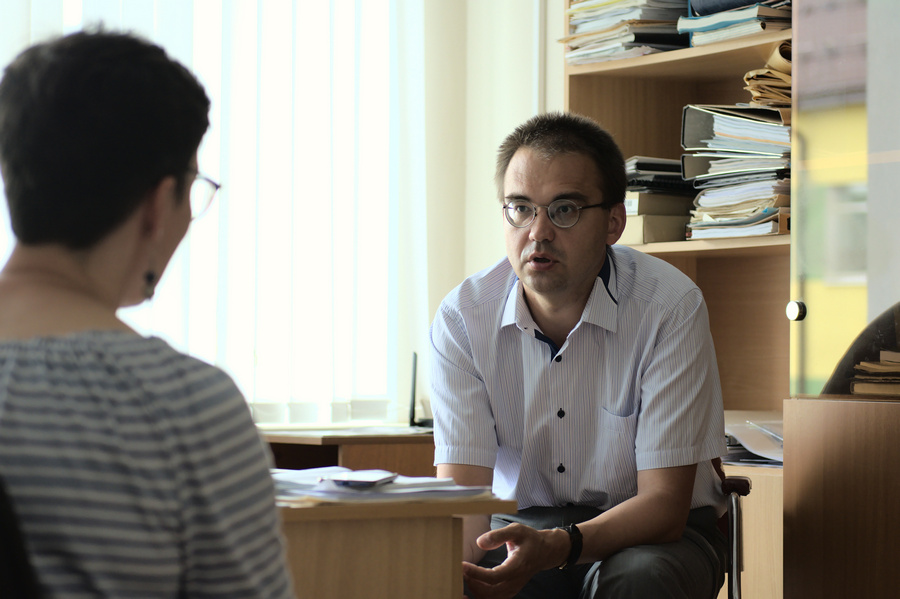About studies of radiation hardness of semiconductor detectors
News, 09 July 2021
Recently, the results of the 2020 Research Award Competition of the Dzhelepov Laboratory of Nuclear Problems have been announced. The DLNP Group of Scientific Communication spoke with the winners about their research.
The first Prize was awarded for the series of papers “Study of radiation hardness of semiconductor detectors of high-resistance GaAs:Cr against electron and fast neutron irradiation carried out at basic JINR facilities” by E. S. Abdel-Shakur, M. I. Gostkin, A. V. Guskov, M. A. Demichev, A. S. Zhemchugov, V. V. Kobets. V. G. Kruchonok, A. Leyva, A. A. Nozdrin and S. Yu. Porohovoy.
It was Aleksei Sergeevich Zhemchugov who talked on behalf of the team about the research behind this series.
 Aleksei Zhemchugov. Photo: DLNP JINR
Aleksei Zhemchugov. Photo: DLNP JINR
Detectors extremely resistant to increased radiation are required for many present-day physics experiments. One of such detectors, a compact electromagnetic calorimeter, is being developed for experiments at future electron−positron colliders by the international FCAL collaboration which comprises scientific centres from Germany, Japan, Russia, the USA, Israel, Belarus, Ukraine, Poland, Romania, Serbia, Chile, as well as two international organizations: CERN and JINR.
Radiation exposure of calorimeters near the beam is extremely high. Sensitive calorimeter elements, semiconductor sensors, suffer the highest damage. The sensors which are usually silicon plates are to be cooled to very low temperatures to compensate for the radiation damage impact. A more radiation-hardened semiconductor material, high-resistance chromium-doped gallium arsenide (GaAs:Cr), whose production technology was elaborated at Tomsk State University (TSU), was proposed by Georgy Aleksandrovich Chelkov as an alternative to silicon in the FCAL project. However, the functional properties of this material and its radiation hardness have still to be carefully studied.
In 2012, with no electron source in Tomsk, the first studies of test samples manufactured at TSU were performed in Darmstadt. Unfortunately, limited time did not allow conducting systematic tests of properties of the new material. However, the results were very promising.
In 2016, a new facility, the LINAC-200 accelerator, appeared in Dubna providing stable electron beams already at the pre-commissioning stage. It was the accelerator that enabled systematic studies exposing prototypes of gallium arsenide and silicon detectors to electrons. A laboratory with test benches was equipped at the DLNP Experimental Department of Colliding Beams where changes in charge collection efficiency, current-voltage characteristics, and other properties caused by radiation damage were determined.
A test zone at the LINAC-200 was established and equipped. It was an important by-product of the studies and can be used in future for further investigations of materials. For example, the FCAL collaboration studies sapphire as one of the materials for sensors. The scientists from Tomsk continue investigating gallium arsenide properties. Recently, Dagestan State University has got in touch with the Dubna group and proposed to examine the radiation hardness of silicon carbide. There is a wealth of directions to go.
The GaAs:Cr samples were also examined for neutron irradiation hardness at the LINAC-200 accelerator and the IBR-2 reactor of the Frank Laboratory of Neutron Physics (FLNP). One of the papers from the series was devoted to these tests.
The performed research evoked great interest. It turned out that the studies started by the FCAL collaboration for the ILC experiments are also of value for alternative future colliders FCC, CLIC, CEPC and for experiments at the European XFEL, the world’s largest X-ray free-electron laser.
Aleksei Sergeevich Zhemchugov also talked about the Dubna project team. It is international. Scientists from Russia, Romania, Cuba, Belarus were involved in the research. The beam studies of materials were also valuable for several Cuban students who included these results in their graduation theses.
The series of papers awarded the first Prize in the 2020 DLNP Award Competition:
- Analysis of radiation effects on some properties of GaAs:Cr and Si sensors exposed to a 22 MeV electron beam / A. G. Torres, A. Leyva, A. Zhemchugov, U. Kruchonak, S. Abou El-Azm and D. Ramos // NUCLEUS 64, (2018) pp. 4-9. ISSN: 0864-084X and 2075-5635
- Radiation hardness of GaAs:Cr and Si sensors irradiated by 21 MeV electron beam / U. Kruchonak, S. Abou El-Azm, K. Afanaciev, G. Chelkov, M. Demichev, M. Gostkin, A. Guskov, A. Leyva, P. Smolyanskiy, A. Tyazhev, N. Zamyatin, A. Zhemchugov // JINST (2020) 15 C06003
- Radiation hardness of GaAs: Cr and Si sensors irradiated by electron beam / U. Kruchonak, S. Abou ElAzm, K. Afanaciev, G. Chelkov, M. Demichev, M. Gostkin, A. Guskov, E. Firu, V. Kobets, A. Leyva, A. Nozdrin, S. Porohovoy, A. Sheremetyeva, P. Smolyanskiy, A. Torrez, A. Tyazhev, O. Tolbanov, N. Zamyatin, A. Zarubin, A. Zhemchugov // Nuclear Inst. and Methods in Physics Research, A 975 (2020) 164204, ISSN 0168-9002.
- Investigation of the radiation hardness of GaAs:Cr semiconductor detectors irradiated with fast neutrons at the reactor IBR-2 / U. Kruchonak, S. Abou El-Azm, M. Bulavin, G. Chelkov, M. Gostkin, A. Guskov, A. Sheremetyeva, N. Zamiatin, A. Zhemchugov // Journal of Physics: Conf. Ser. 1690 (2020) 012042, doi:10.1088/1742-6596/1690/1/012042
- Study of radiation hardness of semiconductor GaAs:Cr detectors to electron and fast neutron irradiation / Uladzimir Kruchonak // Scientific Researches: Results and Prospects. Volume 1, No 4 (2020) ISSN 2713-220X.
Source: DLNP JINR